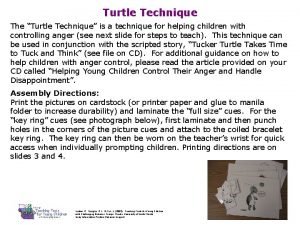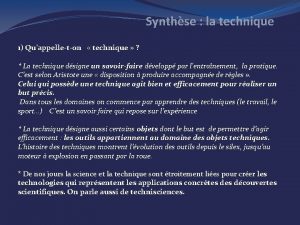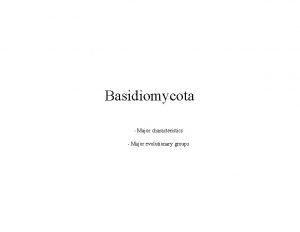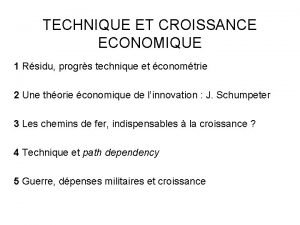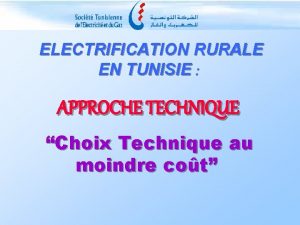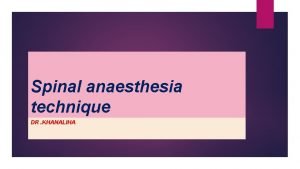PLANNING Notes for Planning is a MAJOR technique



















- Slides: 19

PLANNING

Notes for: Planning is a MAJOR technique in developing the ability of your group. There are “Seven Steps of Planning” which we will discuss here, and then we’ll apply the planning steps to a practical problem: Building your boats! Have them open their books & refer to “the planning procedure chart” page 27. The task we have is.

CONSIDER EVALUATE TASK CONSIDER RESOURCES REACH DECISION PUT PLAN INTO ACTION WRITE DOWN PLAN CONSIDER ALTERNATIVES

1 - CONSIDER THE TASK • What is the task? • When does it have to be done? • Who needs to be involved? • Where do we need to do it? • Why does it need to be done?

Notes for: Consider the Task Go through the questions with your group • What is the task? (To build a boat!) • When does it have to be done? (as soon as you are done learning about planning) • Who needs to be involved? (the entire squad) • Where do we need to do it? (on the picnic benches at the pavillion) • Why does it need to be done? (to learn to work as a squad and to make the best boat possible for the upcoming competition. )

2 - REACH A DECISION • • • WHAT ARE YOU GOING TO DO? IS NO DECISION A GOOD DECISION? WHAT IS THE BEST DECISION ? WHO HAS RESPONSIBILITY? IS NO DECISION AT ALL? IS A POOR DECISION BETTER THAN NO DECISION? • IS A GROUP DECISION BEST?

Notes for: Reach a Decision WHAT ARE YOU GOING TO DO? IS NO DECISION A GOOD DECISION? WHAT IS THE BEST DECISION ? WHO HAS RESPONSIBILITY? IS NO DECISION AT ALL? IS A POOR DECISION BETTER THAN NO DECISION? IS A GROUP DECISION BEST? Decisions need to be made at nearly all steps in the plan. It is important to hear all of the ideas in an orderly way— without shouting and disagreeable statements. The leader is valuable in setting the tone for this phase. He should make it clear that all ideas are welcome, like in brainstorming. He should also have someone write down the ideas, so none are lost.

CONSIDER THE RESOURCES WHAT ARE YOUR NOUNS? • PEOPLE • PLACES, THINGS (Materials) • IDEAS OR IN OTHER WORDS: WHAT DO YOU HAVE TO WORK WITH?

Notes for: Consider the Resources WHAT ARE YOUR NOUNS? PEOPLE PLACES, THINGS (Materials) IDEAS What do we have to work with? Cardboard, Pocket Knives, duct tape, squad members…. What is the best design? Are we most worried about sturdiness, or aerodynamics or Who has had experience building? size?

CONSIDER ALTERNATIVES • WHAT IF SOMETHING GOES WRONG? • WHAT ARE THE EMERGENCY PROCEDURES? • WHAT’S THE ALTERNATE PLAN? • COULD THE ATERNATE BE BETTER THAN THE ORIGINAL PLAN?

Notes for: Consider the Alternatives Depending on the task at hand, this may be a very valuable step. In the case of the boat-building, an alternative idea may make the difference in the boat floating or not! For example: If you were building a fire and it rained on your firewood, what alternative would you have? One idea may be to find dry tinder under the trees.

WRITE DOWN THE PLAN THIS ALLOWS FOR: REVISION REFINING DISCUSSING AMENDING COMMUNICATING

Notes for: Write down the Plan Someone volunteer to sketch out the boat design and allow everyone to have input to: REVISE (maybe there is a better nose or floor design!) REFININE (add this here…. . ) DISCUSS (what if we changed this part to…. . ) AMEND (make the changes on paper first so squad members have the opportunity to have input) COMMUNICATE (Is everyone involved and feel like they are contributing?

PUT THE PLAN INTO ACTION MAKE ASSIGNMENTS GO AND DO

• • The next step now that we have put our plan into action is to EVALUATE. It is important that we step back and calmly and honestly do this step together.

EVALUATE • WHAT WHEN WELL? • WHAT COULD YOU DO DIFFERENTLY? • WOULD YOU DO IT AGAIN? • IF YOU WOULDN’T, WHY NOT?

Notes for: EVALUATE What went well? How could you have done it differently? Would you do it the same way again? If not, why not? Did everyone work together as a squad? Is everyone happy? Do you feel you accomplished the task?

CONSIDER EVALUATE TASK CONSIDER RESOURCES REACH DECISION PUT PLAN INTO ACTION WRITE DOWN PLAN CONSIDER ALTERNATIVES

Planning Sheet What is the task? What are the resources available? What alternatives are there? Write down your design. Work your plan. Evaluate your project. (Refer to page 28 in their books to the “Planning Sheett” Leadership Skills Varsity All-Stars
 Conversion notes brutes en notes standard wisc 5
Conversion notes brutes en notes standard wisc 5 Kontinuitetshantering
Kontinuitetshantering Typiska drag för en novell
Typiska drag för en novell Nationell inriktning för artificiell intelligens
Nationell inriktning för artificiell intelligens Vad står k.r.å.k.a.n för
Vad står k.r.å.k.a.n för Varför kallas perioden 1918-1939 för mellankrigstiden
Varför kallas perioden 1918-1939 för mellankrigstiden En lathund för arbete med kontinuitetshantering
En lathund för arbete med kontinuitetshantering Kassaregister ideell förening
Kassaregister ideell förening Tidbok yrkesförare
Tidbok yrkesförare Sura för anatom
Sura för anatom Förklara densitet för barn
Förklara densitet för barn Datorkunskap för nybörjare
Datorkunskap för nybörjare Tack för att ni lyssnade bild
Tack för att ni lyssnade bild Mall debattartikel
Mall debattartikel Autokratiskt ledarskap
Autokratiskt ledarskap Nyckelkompetenser för livslångt lärande
Nyckelkompetenser för livslångt lärande Påbyggnader för flakfordon
Påbyggnader för flakfordon Lufttryck formel
Lufttryck formel Publik sektor
Publik sektor Lyckans minut erik lindorm analys
Lyckans minut erik lindorm analys




















